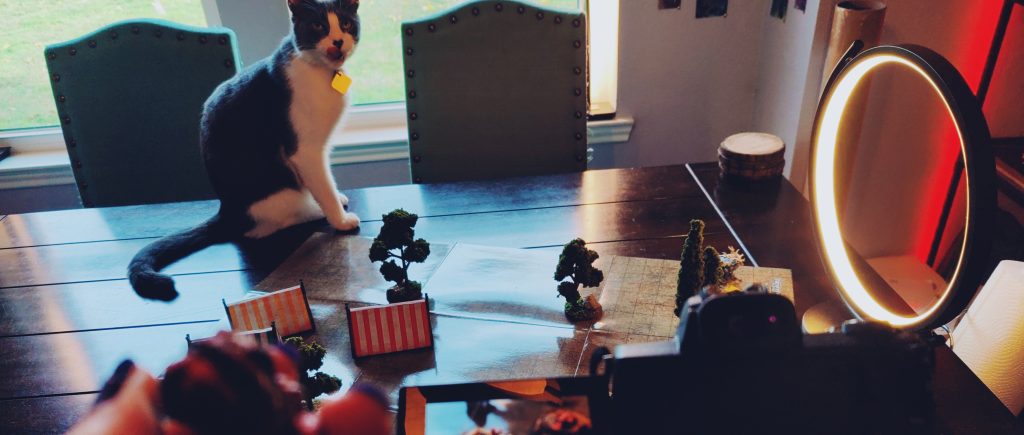
Getting an Angle on Capturing the Action, and a How-To
Readings & Writings
Bare Bones Camera Course for Film and Video chapter 3 describes sequencing while chapter 4 describes screen direction. Both of which will be paramount for this week’s project to produce a How-To video in the Create section below.
Two weeks ago we deep dived into video transitions between shots, now let’s take a step back to understand the shots themselves. In that article I described an experiment involving moving your, the reader’s, eyes around the room to see what your eyes focus on visually. I described the result as…
What you are doing is essentially finding an establishing shot followed by a close-up.
There are many types of shots that make a sequence visually interesting and easy to understand. The establishing shot or wide shot as mentioned above which helps us as the viewer orient ourselves. Moving in closer we have the medium shot and the close-up which are as they sound, closer framings of the subject. A common mixture of these shots is one that uses a cutaway shot, which is a variation of the close-up, to break up the visual monotony of two characters talking in a wide shot with an additional closer framing of the listener to see their reaction to hearing the offscreen subject’s words. This strategy plans ahead for flexible editing that makes it look as though multiple cameras were used to capture the subjects’ interaction, when in fact it’s likely there was one camera that was moved and the scene was repeated in its entirety again.
Planning ahead for editing with tools such as the cutaway shot gives the editor flexibility to make the best cuts possible. Last week I showed an example clip from The Old Ways that was highly intentional with jump cuts, and really any cut should be done intentionally. One way to make a cut feel intentional is to cut on the action which can be done by switching between a shot such as a wide to medium shot while a subject is performing a strong movement suggesting subtle reasoning for our desire as the viewer to look closer.
Similarly there is a concept of a clean entrance and clean exit, which I’ll surely use in my how-to video this week. Rather than starting a shot’s recording already partially through the action, instead we can start and end as cleanly as possible—such as a hand reaching into or out of frame towards the subject.
With all of the possibilities we’ve explored it can be tempting to go wild, but rules of filmmaking and art give us an additional framework to ensure we create something not only good but understandable to the audience as well. In additional to all of the guides art provides such as rule of thirds, another useful one is the 180 degree rule or not crossing the line. The line may overall be placed however you like, most commonly drawn through two subjects extending forever out of frame and then that line should ideally not change again until the scene is done. The purpose of the line? Simple, don’t cross it with your physical camera and you’re unlikely to confuse the directionality of motion of the subjects within the scene while consistently communicating the physical space within it. This planning offers another tool to the editor, one that simply makes it hard to wind up with a confusing scene if the line is not crossed. However, sometimes it is useful to reverse the screen (move the line) but it must be done very intentionally, commonly while cutting on motion as explained earlier.
Research to Inform
In this D&D Stunts gone wrong clip we see a puppet reenactment from a Dungeons and Dragons adventure presumably with some pre-recorded audio from an actual TTRPG live session. There is a mix of wide shots and close-ups throughout. However, what’s interesting here is two-fold.
First, the space is completely made up and with the puppets, felt, and imagined physical space anything is possible and yet the sequence is comprised of shots that never quite cross the 180 degree line of action. However, it does go dangerously close to doing so, which brings us to…
Second, the times the shots nearly cross the line of action is to intentionally fourth wall break, which is key to how Dungeons and Dragons is played. In the game there are the group of heros plus the other characters such as enemy monsters, but there’s also the Dungeon Master who sits behind the screen dictating how the rules and dice are resolved. The intentionality of nearly crossing the line while hiding a puppet behind some bushes clearly communicates to the viewer that those moments are from the perspective of the Dungeon Master.
Finally I’d like to end this section on something abstract and interesting.
Create
I’ve put what has been discussed this week, as an extension of the prior video montage, by recording a how-to video on a favorite topic of mine: Painting for Dungeons and Dragons! In this video I use a single camera to record myself painting two aggressive frogs that will be in combat with the players aboard a boat ride through the swamp. See if you can spot the inconsistencies as I switch between the two slightly different frog miniatures for fun.